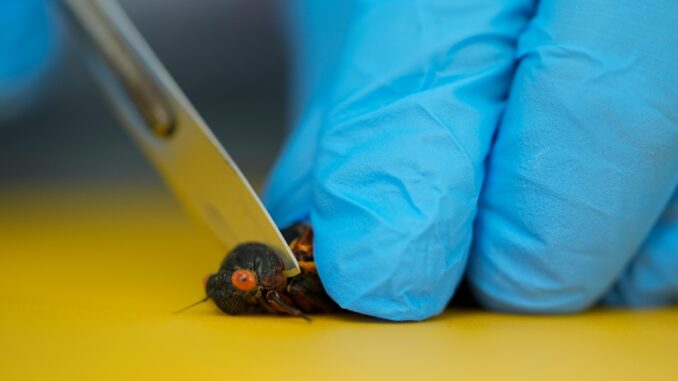
LISLE, Illinois — With their bulging red eyes and their alien-like mating sound, periodical cicadas can seem scary and weird enough. But some of them really are sex-crazed zombies on speed, hijacked by a super-sized fungus.
West Virginia University mycology professor Matt Kasson, his 9-year-old son Oliver, and graduate student Angie Macias are tracking the nasty fungus, called Massospora cicadina. It is the only one on Earth that makes amphetamine — the drug called speed — in a critter when it takes over. And yes, the fungus takes control over the cicada, makes them hypersexual, looking to spread the parasite as a sexually transmitted disease.
“They’re zombies, completely at the mercy of the fungus,” said University of Connecticut cicada researcher John Cooley.
This particular fungus has the largest known genome of any fungus. It has about 1.5 billion base pairs, about 30 times longer than many of the more common fungi we know, Kasson said. And when these periodical cicadas live underground for 17 years (or 13 years in the U.S. South), the spores generally stay down there with them.
“This was a mycological oddity for a long time,” Kasson said. “It’s got the biggest genome. It produces wild compounds. It keeps the host active — all these quirks to it.”
Kasson decided to ask people from around the country to send in infected cicadas this year. And despite an injured leg, Kasson, his son and Macias travelled from West Virginia to the Morton Arboretum outside Chicago, where others have reported the fungus that takes over a cicada’s nether parts, dumping the genitalia and replacing it with a white, gummy yet flaky plug that’s pretty noticeable. The spores then fall out like salt from a shaker.
Infected cicadas are supposed to be hard to find.
Ten seconds after she hops off the golf cart, Macias is in the trees, looking. She emerges victorious, hand in the air with a cicada, yelling “I got one.”
“That was just lucky,” Oliver whines.
“Luck, huh? Let’s see you get one,” Macias replies.
Ten seconds later at a neighboring bush, Oliver finds another. And just a bit after that a photographer finds a third.
Kasson and his small team collected 36 infected cicadas in his brief Chicago area jaunt with people sending him another 200 or so from all over. He’s still waiting for an RNA analysis of the fungus.
Some cicada experts have estimated maybe one in 1,000 of the periodical cicadas are infected with this fungus, but it’s not much more than a guess. Mount St. Joseph University’s Gene Kritsky, a biologist who wrote the book on this year’s unique dual emergence, said it might be skewed because the healthy cicadas stay higher up in the trees.
This year “the fungus is about how it always is,” Cooley said in an email. “It’s not super common.”
There’s debate among scientists if the fungus infects more cicadas deep in the soil coming out of the ground after 13 or 17 years or if it infects the newly hatched nymphs on the way underground for more than a decade.
This fungus isn’t the type of parasite that kills its host, but instead it needs to keep it alive, Kasson said. Then the infected cicadas attempt to mate with others, spreading the spores to its mate/victim. The males even pretend in their hypersexualized state to be females to entice and infect other males, he said.
The cousin to this fungus which infects annual cicadas out west also makes a psychoactive compound in the cicadas but it is more akin to psychedelics like magic mushrooms, Kasson said. So sometimes people, even experts, mix up the amphetamine that the infected 17- and 13-year cicadas produce with the more trippy compounds of the annual bugs, he said.
Either way, don’t try it at home. Even though cicadas themselves are edible, not so much the infected ones.
In the interest of science, Kasson tried one during this emergence, making sure they were from the inside of a female so more antiseptic.
“Man, it was so bitter,” Kasson said, explaining that he immediately rinsed his mouth out. “It tasted like something you would consider poisonous.”
___
Read more of AP’s climate coverage at http://www.apnews.com/climate-and-environment
___
Follow Seth Borenstein on X at @borenbears
___
The Associated Press’ climate and environmental coverage receives financial support from multiple private foundations. AP is solely responsible for all content. Find AP’s standards for working with philanthropies, a list of supporters and funded coverage areas at AP.org.


Be the first to comment